Whenever bleeding takes place anywhere in the body, all the proteins responsible for halting that bleeding immediately travel to the injured tissue. Clotting, which takes place with the cooperation of a great many proteins, is an irreducibly complex process that cannot be explained by evolution.
The NAS's Errors In The Chapter On Creationism and The Evidence For Evolution
Why The Geological Column Is Not Evidence for Evolution
Since the NAS authors are blindly devoted to the theory of evolution, they are even capable of interpreting evidence that works against the theory as evidence in favor of it. One example of this is their interpretation of the fossil record: according to the NAS, fossils are found in an orderly sequence in the Earth, and similar species are set out in consecutive layers. Evolutionists then portray this as evidence of evolution. However, this claim is exceedingly deceptive and totally ignores the real message of the fossil record.
It first needs to be made clear that even if living things were set out in order in the Earth's geological strata, this would still not be proof of evolution. In order for such an arrangement to be considered evidence of evolution, fossils of those creatures that provided transitions between species alleged to have evolved from one another should also be found in the strata. As we have seen in earlier chapters, however, these transitional forms are nowhere to be found. Furthermore, beyond the fossil record, branches of sciences such as morphology, genetics, and biochemistry have all proven that such transitional forms are impossible. These branches of science have demonstrated that living species cannot descend from one another by evolution. In conclusion, even if there were a fossil sequence in the Earth, as evolutionists claim, this would not constitute proof of evolution.
The most important aspect of this is, without a doubt, the fact that the evolutionary history referred to by the NAS does not exist. The Cambrian explosion, which is known to have taken place some 550 million years ago, is a clear indication that life on Earth did not come about through evolutionary development, but rather emerged suddenly with all its complex forms of life already in existence. The NAS authors fail to make a single reference drawing attention to the Cambrian explosion. Yet this booklet claims to be a response to the proponents of creationism. The Cambrian explosion heads the list of subjects of interest to the proponents of creation, and is one of the most important dilemmas facing the theory of evolution.
All the animal phyla known today emerged at the same time, in the geological age known as the Cambrian Period.This lasted some 65 million years and took place some 570 to 505 million years ago.
The "Cambrian explosion" refers to a shorter time within the Cambrian period, when the main animal groups suddenly emerged. In an article from 2001, based on a detailed examination of the literature, Stephen C. Meyer, P.A. Nelson, and Paul Chien wrote, "Cambrian explosion occurred within an exceedingly narrow window of geologic time, lasting no more than 5 million years."1
In the fossil record before that period, there is no trace of life other than single-celled creatures and a few very simple multi-celled ones. Yet, all the animal phyla emerged suddenly, fully formed, in a period as short as 5 million years (which is very short in geological terms)! An article published in Science in 2001 said: "The beginning of the Cambrian period, some 545 million years ago, saw the sudden appearance in the fossil record of almost all the main types of animals (phyla) that still dominate the biota today."2 The same article also stated that in order for such complex and very different forms of life to be accounted for in terms of the theory of evolution, fossil beds showing a rich and gradual development from earlier periods should be found, but that this is out of the question:
Other paleontologists have questioned whether such rapid evolution is possible and have instead postulated a phylogenetic "fuse"—an extended period of evolutionary genesis that has left little or no fossil record. 3
The fossils found in Cambrian beds belong to such very different creatures as snails, trilobites, sponges, worms, star fishes, sea urchins, and sea lilies. Most of the living things in these strata possess complex systems such as eyes, respiratory and circulatory systems, and other advanced physiological structures no different from those of modern specimens. These structures are both very complex and very different from each other. They all emerged suddenly, with no evolutionary ancestors.
The only modern phylum whose origins in the Cambrian Period have ever been in doubt is Chordata, which includes vertebrates. However, two fossil fish found in 1999 demolished the evolution hypothesis with respect to chordates, as well. These fish, known as Haikouichthys ercaicunensis and Myllokunmingia fengjiaoa, belong to the Cambrian Period and are 530 million years old. A report by the well-known paleontologist Richard Monastersky, called "Waking Up to the Dawn of Vertebrates," described the importance of the discovery:
Paleontologists have long regarded vertebrates as latecomers who straggled into evolutionary history after much of the initial sound and fury had fizzled. Chinese paleontologists, however, have discovered fossils of two fish that push the origin of vertebrates back to the riotous biological bash when almost all other animal groups emerged in the geologic record.Preserved in 530-million-year-old rocks from Yunnan province, the paper clip-size impressions record the earliest known fish, which predate the next-oldest vertebrates by at least 30 million years.4
This evidence that vertebrates also emerged during the Cambrian Period demolished all hopes of locating the history of life within an evolutionary framework.

Professor Phillip Johnson of University of California at Berkeley, one of the most important critics of evolution in the world, describes how this fact openly conflicts with Darwinism:
Darwinian theory predicts a "cone of increasing diversity," as the first living organism, or first animal species, gradually and continually diversifies to create the various levels of the taxonomic order. The animal fossil record more resembles such a cone turned upside down, with the phyla present at the start and thereafter decreasing.5
As Johnson makes clear, far from emerging gradually, all the phyla emerged suddenly, with some becoming extinct in later periods.
It is therefore possible to understand why the NAS authors failed to mention the Cambrian explosion, described by Roger Lewin as "the most important evolutionary event during the entire history of the Metazoa"6—neither the NAS authors nor any other evolutionist dares say anything about the Cambrian explosion. Therefore, they choose to ignore the phenomenon, as well as all the other evidence that undermines the theory of evolution.
The Missing Argument: "No One Has Seen Evolution Occur"
The NAS authors suggest that one of the creationists' main theses is that "no one has seen evolution occur." In fact, however, this is not a creationist thesis, and can only be a claim put forward by a few individuals. We do not claim that "the theory of evolution is not true because no one has seen evolution occur." As the NAS authors make clear, there is no need for evolution to be witnessed in order for the theory of evolution to be proven; if the theory of evolution is true, all that is needed is for its results or mechanisms to be observed. If evolution did take place, then we should find ample evidence of this fact. For example, transitional forms should be discovered in the fossil record that prove that living things descended from one another. Genetic analyses should show that the structures of living things claimed to have an evolutionary family relationship are similar to one another and different from other species. Family trees built on the basis of genetic and morphological similarities should be mutually consistent. The way in which complex structures came into being through chance mechanisms should be capable of explanation. And the increases in genetic information in living things caused by mutation should be observed in laboratory experiments.

Had evolution really taken place, transitional forms such as half-reptile/half-mammals and halfreptile/ half-birds, similar to those in these pictures, should be found in the fossil record. Yet, no trace of such forms has been found.
As we have seen throughout this book, however, the fact is that neither natural history, nor branches of science such as biology, morphology, paleontology, microbiology, biochemistry, and genetics, provide any results suggesting that evolution ever took place. On the contrary, the results from all these branches of science offer evidence that living things are individually created. In conclusion, although it is impossible for us to observe creation, the information from all the research and experiments in these branches clearly indicate that living things are created.
"Evolution in Action": Just In the Minds of Its Supporters
The NAS authors cite several examples of evolution occurring every day: bacterial resistance to antibiotics, the resistance of mosquitoes to insecticides, and the resistance of malaria parasites to drugs (Science and Creationism, p. 21).
We have already discussed the fact that the gradual acquisition by bacteria of resistance to antibiotics has nothing to do with evolution, and we shall not repeat this material here. In the same way, the acquisition by mosquitoes of resistance to pesticides is also not evidence of evolution.
Why immunity to DDT is not evidence for evolution
Evolutionists often attempt to portray the way in which mosquitoes and other insects acquire resistance to pesticides such as DDT as evidence in favor of the theory of evolution; however, the truth is very different. It is a mutation that makes insects resistant to pesticides. This mutation, however, does not constitute evidence for the theory of evolution.
Before examining this, let us briefly summarize the effect of DDT on insects. A DDT molecule attaches itself to a specific matching site on the membrane of the insect's nerve cells. It thus prevents the nerve from functioning properly. When sufficient DDT molecules attach themselves to the nerve cells, the nervous system collapses and the insect dies. 7

So, how does an insect acquire resistance to DDT? By losing its sensitivity to DDT. This loss is the result of a mutation that alters the area in the nerve cell to which the DDT molecule normally attaches itself.8 Any mutation that prevents DDT from attaching to the nerve cell will make the insect resistant to the poison. Just as in the case of bacteria, insects can also gain resistance if the functioning of a nerve cell protein is reduced in just the right way.
Evolutionists portray the acquisition by insects of resistance by means of mutation as evidence for the theory of evolution. Yet, they forget—or deliberately ignore—one very important point: the alteration of an amino acid within a protein usually affects the functioning of that protein. Although such a change in a protein may bring resistance to poisons such as DDT, it may also lead to the loss of other functions or features. Naturally, as long as the pesticide in question is around, the creature gains resistance and survives, albeit at the cost of being less well adapted in some other way. When the poison is removed, however, the non-resistant species is again at an advantage.
M.W. Rowland from the Rothamsted Experimental Station in England reported that mosquitoes made resistant to dieldrin became less active and slower to respond to stimuli than other insects.9 The resistance of insects to the poison was acquired at the cost of a "sluggish" nervous system. The loss of information at the molecular level emerges as a loss in the insects' performance.
Therefore, it is erroneous to regard the mutations that bring about resistance to pesticides as an example of evolution. Such resistance mechanisms stop the poison or antibiotic from working by causing damage to the structure of the insect or bacterium. This may bring about resistance, but it cannot increase the insect's or bacterium's genetic information. On the contrary, in all observed cases a loss of one sort or another has always been identified. There is, therefore, no evolution here. The resistance of bacteria to antibiotics and of insects to DDT does not constitute evidence of evolution.
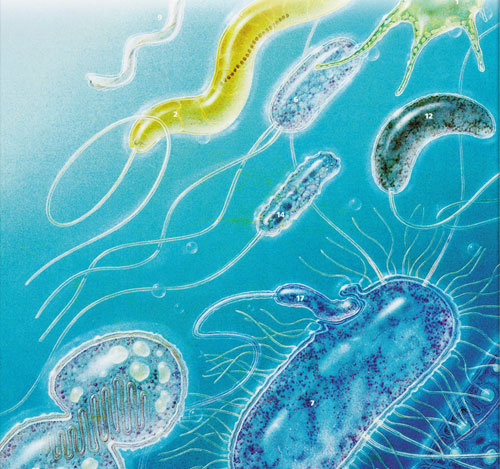
A Problem Too Complex for NAS: Irreducible Complexity
The "irreducible complexity" of structures and systems in living things is one of the most serious dilemmas facing the theory of evolution. According to the theory, all the stages undergone as one living thing evolves into another need to be advantageous. To put it another way, in a process of evolution from A to Z, all the intermediate stages, B,C,D … W,X,Y, must be of some benefit. Since it is impossible for natural selection and mutation to consciously identify an objective in advance, the theory depends on the assumption that all the systems in living things can be "reduced" to myriad small steps, and that each individual transition from one step to another is beneficial to the organism.
That is why Darwin said, "If it could be demonstrated that any complex organ existed, which could not possibly have been formed by numerous, successive, slight modifications, my theory would absolutely break down."10
Darwin may have imagined, in the primitive state of science in the nineteenth century, that living things did possess a reducible structure. Scientific discoveries during the course of the twentieth century, however, have revealed that many organs and systems in living things cannot be reduced to simple forms. This fact, known as "irreducible complexity," destroys Darwinism, just as Darwin himself feared.
Although the concept of irreducible complexity is sufficient to demolish the theory of evolution all on its own, the NAS authors do devote some space to it. However, they do so only to suggest, in a manner devoid of any proof or logic, that irreducibly complex structures are really nothing of the sort:
However, structures and processes that are claimed to be "irreducibly" complex typically are not on closer inspection. For example, it is incorrect to assume that a complex structure or biochemical process can function only if all its components are present and functioning as we see them today. Complex biochemical systems can be built up from simpler systems through natural selection. (Science and Creationism, p. 22)

A jawless fish that lived in the mesozoic period
According to NAS, the reason why the hemoglobin of jawed fish is more complex than that of jawless fish is that the former evolved from the latter. The fact is, however, that there is no scientific evidence to support this claim.
The NAS authors cite the hemoglobin molecule as an example of their claim. According to the NAS claim, jawed fish evolved from jawless ones. The hemoglobin of the former is more complex than that of the latter. In other words, according to the NAS, the irreducibly complex hemoglobin of a jawed fish evolved from the hemoglobin in a simpler animal. With this claim, the NAS imaginesit has explained how an irreducibly complex molecule came into being!
This is pure fantasy, since nothing has been said that might benefit the theory of evolution. In attempting to explain the origin of irreducibly complex structures, the NAS authors rely not on a concrete scientific truth but on the assumptions of the theory of evolution. The evolution of jawed fish from jawless fish is a Darwinist assumption, not a scientific fact. Offering one assumption, itself lacking any proof, as evidence for another is at best a logical fallacy and at worst an outright deception. But this is precisely what the claim that "irreducibly complex organs can actually be reduced" amounts to!
It is also erroneous to portray the degree of complexity among the hemoglobin molecules in different living things as evidence for evolution. This is because what evolutionists need to do is not just to determine the degree of complexity between two different hemoglobin molecules, but rather to explain how hemoglobin (and all other proteins) came into being in the first place.
By claiming that a simple hemoglobin molecule turned into a more complex one, the NAS authors may imagine that they have accounted for the origin of an irreducibly complex molecule; however, they overlook (or else choose to ignore) the fact that the hemoglobin they refer to as "simpler" itself has an irreducibly complex structure.
Hemoglobin Molecule
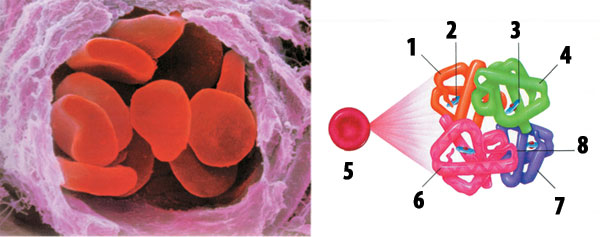
1) Alpha chain
2) Iron
3) Heme group
4) Beta chain
5) Red Blood Cell
6) Beta chain
7) Alpha chain
8) Helix shape of the polypeptide molecule
The way the NAS authors seek to avoid the problem of irreducible complexity is by dreaming up a series of "primitive" intermediate stages for these complex structures. They write that "Natural selection can bring together parts of a system for one function at one time and then, at a later time, recombine those parts with other systems of components to produce a system that has a different function." (Science and Creationism, p. 22) Fine, but what are these different functions? That is the real question, and it is one to which the NAS authors have no answer and for which they are unable to offer any evidence or examples. What they need to do is to give an example of a structure or organ acquiring functions while changing from a simpler to a more complex form, and to back this up with evidence. Moreover, it is also apparent that if these intermediate functions are also complex, they will still be left facing the same difficulty.
In addition, the NAS authors also refer to natural selection as if it were a conscious force. They speak of it as though it already knew what the future desired function was and as though it always produced a useful function by gradually adding the appropriate components together. In point of fact, however, natural selection is an unconscious natural mechanism and cannot act according to any plan.
What is the origin of the particular organs and systems in living things? How did new genetic information to describe them come about? Like all evolutionists, the NAS authors have not the slightest idea. As we saw in earlier chapters, mutations cannot acquire beneficial characteristics for living things. So, how are the new functions they hope will be chosen by natural selection acquired? That vital question goes unanswered. The world's most prominent evolutionists merely say, "Natural selection does this," without offering any evidence, believing that they have thus put forward an evolutionary explanation of the irreducible complexity in the structures and systems in living things.
For example, the NAS evolutionist authors attempt to explain the complicated biochemical processes that take place during blood clotting in terms of genes' being duplicated and altered, and their effects amplified by natural selection. Gene copying is one answer that the NAS authors give to the question of how genetic information can be added to a living thing. According to this account, a living thing makes more than one copy of its genes. A mutation then takes place in that extra copy and a change thus takes place in the living thing's genetic information. Since this change occurs in the duplicate gene, it does not affect the organism, and thus the functioning of the gene is not impaired. The mutated gene is a copy.
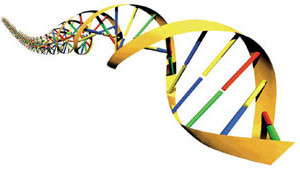 Unfortunately, however, the gene duplication explanation contributes nothing to the theory of evolution. This is because the right gene needs to duplicate for no reason at exactly the right time (in other words just when the organism requires a new function). Then, this gene copy needs to undergo a precisely appropriate mutation, which adds a new function to the organism.
Unfortunately, however, the gene duplication explanation contributes nothing to the theory of evolution. This is because the right gene needs to duplicate for no reason at exactly the right time (in other words just when the organism requires a new function). Then, this gene copy needs to undergo a precisely appropriate mutation, which adds a new function to the organism.
To believe that so many coincidences can happen one after the other, and to imagine that this gave rise to the millions of different species in the world, is quite irrational. Genes duplicate very seldom. The researchers M. Lynch and J. S. Conery from the University of Oregon have stated that gene duplication takes place on average once every 100 million years.11 Furthermore, the great majority of duplicated genes have been found to disappear within a few million years.12 If we consider that the most obvious characteristic of structures with irreducible complexity is that they consist of several components, then it can be seen just how impossible it is for a gene to bring together the right components at exactly the right time by duplication.
In fact, even evolutionists greet the claim that gene duplication gave rise to evolution with suspicion. Lynch and Conery, for instance, state that the mechanisms that allow gene duplication to contribute to evolution are unclear:
However, it is unclear how duplicate genes successfully navigate an evolutionary trajectory from an initial state of complete redundancy, wherein one copy is likely to be expendable, to a stable situation in which both copies are maintained by natural selection. Nor is it clear how often these events occur. 13
The impossibility of the mechanisms favored by the NAS as gradually giving rise to evolution is evident. Moreover, the NAS authors, who claim that the blood clotting process may have gradually evolved by means of these mechanisms, need to prove these claims in some detail. For example, they should address such questions as "which genes underwent what kind of change, when, and how?," or "what feature or function did this change bring about that was advantageous to the organism, without causing collateral damage?" A diagram of the blood clotting process can be seen in the figure on page 240. It is clear from this diagram that the chance mechanisms of evolution cannot possibly answer the question of how such a system came into being, and that evolutionist accounts are nothing more than baseless demagogy.
Finally, the NAS booklet considers the irreducible complexity in the structure of the eye. The error of logic made regarding hemoglobin is repeated here, where it is suggested that the complex eye evolved from a simpler one. The fact is, however, that every eye, no matter what its level of complexity, still possesses irreducible complexity. The NAS authors claim that the complex eye gradually formed from a single, very simple, light-sensitive spot, saying "The steps proceed from a simple eye spot made up of light-sensitive retinula cells (as is now found in the flatworm)..." (Science and Creationism, p. 22) The point that needs to be considered here, though, is how simple—or rather how complex—the spot referred to by the NAS authors actually is.
In order for "sight," even in its simplest form, to emerge, certain cells in an organism need to become sensitive to light and to possess the ability to transform that sensitivity into electrical signals. Then, a special nerve network is needed to transfer these signals from the light-sensitive cells to the brain, as well as a visual centre in the brain to analyze that information. It is irrational to suggest that all this could happen by chance, all at once and all in the same creature. In his book Evrim Kurami ve Bagnazlik (The Theory of Evolution and Bigotry), written with the aim of defending the theory of evolution, the Turkish evolutionist author Cemal Yildirim accepts this fact in these words:

In order to see, there is a need for a large number of mechanisms to cooperate: we may speak of links between the eye and its internal mechanisms and between the eye and the special center in the brain. How did this complex structure come about? According to biologists, during the process of evolution the first step in the formation of the eye was taken with the formation of a small, light-sensitive region in the skins of certain primitive creatures. However, what evolutionary advantage could such a small occurrence bestow on an organism all by itself? Together with that region, a nerve network connecting it to a visual centre in the brain would also need to be constructed. Unless these rather complex mechanisms are linked together, we cannot expect the phenomenon we know as "sight" to emerge. Darwin believed that variations emerged at random. If that were so, would it not be a mysterious puzzle how the great number of variations necessary for sight all came together and cooperated at the same time in various different parts of the organism's body? ... The fact is that a string of complementary changes—all of which must work together—are necessary for sight ... Some molluscs' eyes have retina, cornea, and a lens just like ours. How can we account for this construction in two species on such very different evolutionary levels solely in terms of natural selection? … It is a matter for debate whether Darwinists can supply a satisfactory answer to that question…14
Another point which makes that question even more of a dilemma for evolutionists is the eye of the trilobite, one of those creatures which suddenly emerged during the Cambrian explosion. This 530-million-year-old compound eye structure is an "optical marvel" which functions with a double lens system, and is the oldest known eye. This totally undermines the evolutionists' claim that "complex eyes evolved from primitive eyes."
This question poses such a severe problem for the theory of evolution that the more detailed the analysis, the more intractible the problem becomes. One important "detail" that needs to be examined at this point is the tale of the "cell becoming sensitive to light." What kind of design does this structure—which Darwin and other evolutionists have glossed over by saying, "sight may have begun by a single cell becoming light-sensitive"—actually have?
Blood Clotting: An Irreducibly Complex System
You know that when you cut yourself, or when an old injury starts bleeding, the bleeding will eventually stop. A scab will form over the injury and the wound will heal. This may seem very simple and normal. Yet, biochemical research has revealed that this is the result of the working of an extremely complex system. (Michael Behe, Darwin's Black Box, New York: Free Press, pp. 79-97) Damage to, or the absence of, just one of the components of this system will cause it to stop functioning.
The blood must clot at the right time and in the right place, and the clotting must stop once normal conditions have returned. The system must work flawlessly right down to the very tiniest detail.

In the event of bleeding, clotting needs to take place at once if the creature is not to die from loss of blood. It is also essential that the clotting take place all over the wound and, most important of all, that it should only take place at the site of the injury. Otherwise, all the creature's blood will clot and solidify, which will kill it. Blood clotting, therefore, has to be kept under careful control, and has to occur at the right time and place.
The blood platelets or thrombocytes, particles produced by the bone marrow, possess an indispensable property. These particles are the main components of clotting. A protein known as von Willebrand factor ensures that the thrombocytes which keep moving around in the blood do not go past the wound. The thrombocytes become caught at the injury site, and release a substance that brings others to the same location. Working together, these cells eventually close up the wound. Then, the thrombocytes die, after having served their purpose. The way they sacrifice themselves is just one part of the blood clotting system.
Another protein that brings about blood clotting is thrombin. This substance is only produced where there is an open wound. There must be neither too much nor too little produced. Moreover, production must occur and stop at just the right times. So far, more than 20 bodily chemicals have been identified as playing a role in the production of thrombin. These enzymes can trigger its reproduction or halt it. The system is so controlled that thrombin only forms when there is injury to tissue. As soon as all the enzymes needed for blood clotting have arrived, thrombin trims some protein chains in fibrinogen. The trimmed protein, now called fibrin, soon form a network. This network covers the area where the blood is flowing out. The thrombocytes in the blood also attach themselves to this network. As this accumulation grows thicker, it stops the flow of blood by acting as a plug. What we know as a blood clot is the plug formed by this accumulation.
When the wound is completely healed, the clot falls apart.
This system—which brings about the formation of a blood clot, and either strengthens or removes it, as necessary—possesses the feature of irreducible complexity. The clotting of the blood emerges from a chain of events in which one component spurs another into action. A diagram setting out the process appears on page 240. It can be seen at a glance just what a complex process is involved. The system works flawlessly, right down to the smallest detail.
What would happen if even the smallest thing were to go wrong in this magnificently functioning system—if, say, there was blood clotting in the absence of any wound, or if the scab forming over the wound came off too easily? There is only one answer to these questions. In such an event, the bloodstream to such essential organs as the heart, liver, or brain would be clogged with clots. That, in turn, would inevitably end in death.
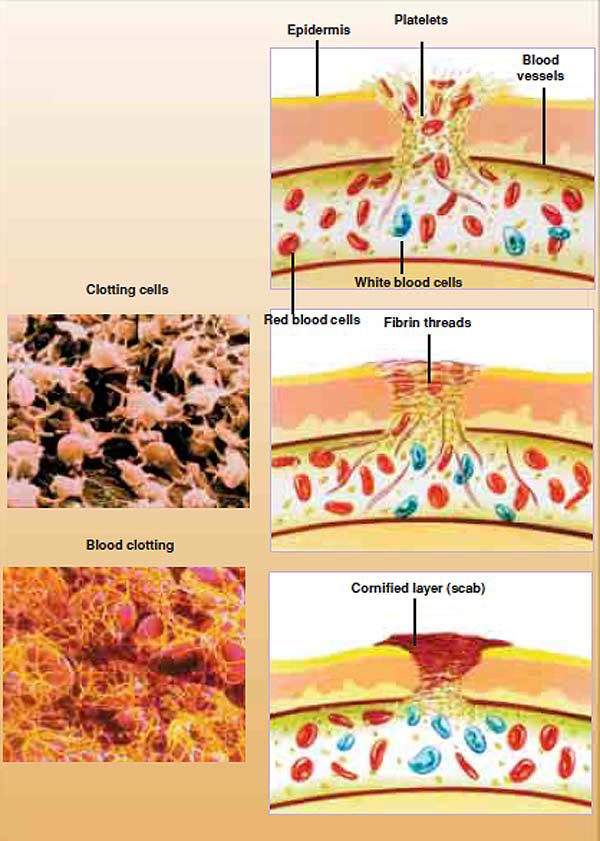
Once again, this shows us that the human body has been flawlessly designed. It is impossible to account for even the blood clotting system in terms of chance and the theory of evolution's notion of "gradual development." This system, every detail of which is the product of a separate plan and calculation, reveals the perfection of creation. Our Lord Who creates us has created our bodies with this system, which protects us throughout the course of our lives from injuries great and small.
The Clotting Mechanism
The diagram below shows the blood clotting mechanism. Clotting comes about as a result of a great many chemical substances taking their place in a specific order. A similarly complex procedure occurs in order to bring the clotting process to a halt.
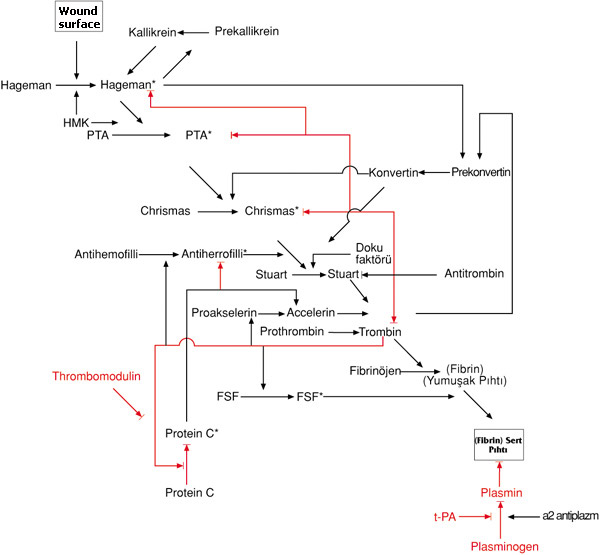
| • | -> | Proteins that are involved in promoting clot formation |
| • | ->| | Proteins that are involved in the prevention, localization, or removal of blood clots. |
Blood clotting is important not just for visible cuts, but also for the repair of ruptured blood vessels, something which happens in our bodies every day. Although you are not aware of it, you constantly experience tiny hemorrhages throughout the course of the day. When you knock your arm against the door frame or sit down hard on a chair, hundreds of tiny blood vessels rupture. The hemorrhaging that occurs as a result of these blows is immediately halted thanks to the coagulation system, and the body later goes on to repair the ruptured blood vessels. If the blow is quite violent, the hemorrhaging that occurs before clotting sets in is rather more violent—which is the reason "bruising" occurs. An individual who lacks this clotting system in the blood will need to be protected from the slightest blow throughout his life, and even wrapped up in cotton wool. Hemophiliacs, who do lack just this system, spend their lives in this very manner. Seriously afflicted individuals tend not to live long. Internal bleeding caused by something as slight as tripping while walking can be enough to kill them. In the face of this, everyone should stop to consider the miracle of creation within his own body and give thanks to God Who has created that body so flawlessly. This body, of which we are unable to create a single system or even a single cell, is a blessing from God. As God states in one verse:
We created you so why do you not confirm the truth? (Qur'an, 56: 57)
The Complex System of Sight
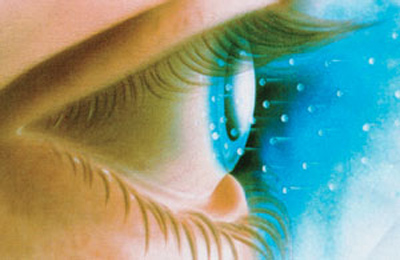
How does the system of sight, which the NAS evolutionists gloss over as being a simple structure, work? How do the cells in the retina perceive the light particles that fall on them?
The answer to this question is rather complicated. When photons strike the cells in the retina, they activate a chain reaction, rather like a domino effect. The first of these dominoes is a molecule called "11-cis-retinal," which is sensitive to photons. The moment a photon strikes it, the 11-cis-retinal molecule changes shape. This change also alters the form of the protein "rhodopsin," which is linked to 11-cis-retinal. In this way, rhodopsin becomes able to bind to another protein called "transducin."
Before reacting with rhodopsin, transducin is attached to another molecule called GDP. When it binds to rhodopsin, it releases GDP and attaches to another molecule called GTP. Two proteins (rhodopsin and transducin) and one phosphate molecule (GTP) are now attached to one another. This entire structure is known as "GTP-transducinrhodopsin." Yet, the process has barely begun. The new compound GTP-transducinrhodopsin is now compatible with yet another protein, called "phosphodiesterase," which is already in the cell. This connection is immediately made. As a result of this, the phosphodiesterase protein acquires the ability to split a molecule called cGMP, which is again already in the cell. Since this process is carried out by not just a few, but by millions of proteins, the level of cGMP in the cell falls rapidly.
What has all this to do with sight? In order to find the answer to this question, let us have a look at the final stage of this interesting chemical reaction. The drop in the density of cGMP within the cell affects the "ion channels" in the cell. These are proteins that regulate the number of sodium ions in the cell. Normally, the ion channel allows sodium ions to flow into the cell from outside, while another molecule expels the unnecessary ions, thus creating a balance. When the number of cGMP molecules falls, so does the number of sodium ions. This quantitative change gives rise to an electrical imbalance in the cell. This electrical imbalance affects the nerves connected to the cell, and what we call an "electrical impulse" forms. The nerves forward these signals to the brain, where what we refer to as "sight" is experienced.15

Vitreous humor
Retinal blood vessels
Optic nerve
Retina
Choroid
Sclera
Layers of the retina:
LIGHT RECEPTORS
Pigment containing segments
Nucleus
Cone cell
Rod cell
Bipolar cell
Ganglion cell
Fibers to optic nerve
Light passing through the eye must pass through several layers of retinal cells before reaching the lightsensing rods and cones.
RETINA
Light
Horizontal cell
Cone cell
Rod cell
Pigmented tissue
Ciliary body
Suspensory ligaments
Cornea
Lens
Iris
In short, a single photon strikes just one of the cells in the retina, and thanks to the ensuing chain reaction, the cell is enabled to produce an electrical impulse. This varies according to the energy of the photon, giving rise to the concept of "strong" and "weak" light. One of the most interesting aspects of this whole process is the fact that all of the complex reactions described above take place in one-thousandth of a second, at most. Even more interesting is the fact that when this chain reaction is completed, certain special proteins within the retinal cell—including 11-cis-retinal, rhodopsin, and transducin—return to their previous states. Thus, as the eye is struck by new photons every moment, the chain reaction system within the cells of the retina enables the person to perceive every one of these photons.
The process of seeing that we have summarized here actually contains a great many more complex details. Yet, even this crude picture is enough to show what a magnificent system we are dealing with. The eye is such a complex, such a finely tuned system that it is totally irrational to maintain that it could have come about by chance. The system possesses a complex structure that is completely irreducible. The absence of even a single one of the huge number of molecules that enter into chain reactions with one another would mean the utter failure of the whole system.
The lethal blow that this system deals to the Darwinist explanation of life as something random is obvious. Michael Behe makes this comment on the chemistry of the eye and the theory of evolution:
Now that the black box of vision has been opened, it is no longer enough for an evolutionary explanation of that power to consider only the anatomical structures of whole eyes, as Darwin did in the nineteenth century (and as popularizes of evolution continue to do today). Each of the anatomical steps and structures that Darwin thought were so simple actually involves staggeringly complicated biochemical processes that cannot be papered over with rhetoric.16
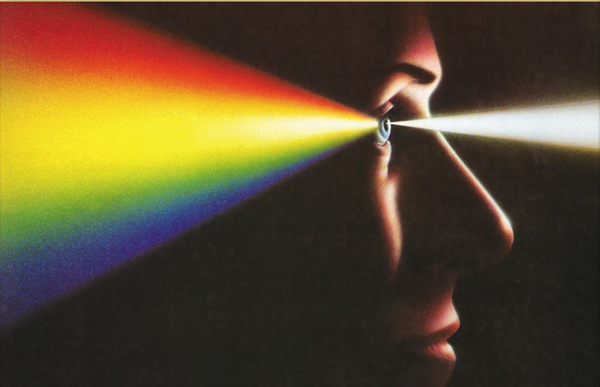
The irreducibly complex structure of the eye causes the Darwinist theory to "absolutely break down,"17 as Darwin himself put it. It also demonstrates conclusively that life is created with a most superior design.
NOTES
1. Stephen C. Meyer, P. A. Nelson, and Paul Chien, The Cambrian Explosion: Biology's Big Bang, John A. Campbell, ed., Intelligent Design, Darwinism, and the Philosophy of Public Education.
2. Richard Fortey, "The Cambrian Explosion Exploded?," Science, vol. 293, no 5529, July 20, 2001, pp. 438-439.
3. Richard Fortey, "The Cambrian Explosion Exploded?," Science, vol. 293, no 5529, July 20, 2001, pp. 438-439.
4. Richard Monastersky, "Waking Up to the Dawn of Vertebrates", Science News, vol. 156, no. 19, November 6, 1999, p. 292. (emphasis added)
5. Phillip E. Johnson, "Darwinism's Rules of Reasoning", in Darwinism: Science or Philosophy?, Foundation for Thought and Ethics, 1994, p. 12. (emphasis added)
6. R. Lewin, Science, vol. 241, July 15, 1988, p. 291.
7. R.W. Beeman, "Recent advances in the mode of action of insecticides," Annual Review of Entomology, 1982, vol. 27, pp. 253-281.
8. K. Tanaka, J. G. Scott, F Matsumura, "Picrotoxinin receptor in the central nervous system of the American cock-roach: its role in the action of cyclodiene-type insecticides", Pesticide Biochemistry and Physiology, 1984, vol. 22, pp. 117-127.
9. M. W. Rowland, "Fitness of insecticide resistance", Nature, 1987, vol. 327, p.194.
10. Charles Darwin, The Origin of Species: A Facsimile of the First Edition, Harvard University Press, 1964, p. 189.
11. M. Lynch, J. S. Conery, "The Evolutionary Fate and Consequence of Duplicate Genes" Science, 290:1151-1155, Nov 10, 2000.
12. M. Lynch, J. S. Conery, "The Evolutionary Fate and Consequence of Duplicate Genes" Science, 290:1151-1155, Nov 10, 2000.
13. M. Lynch, J. S. Conery, "The Evolutionary Fate and Consequence of Duplicate Genes" Science, 290:1151-1155, Nov 10, 2000.
14. Cemal Yildirim, Evrim Kurami ve Bagnazlik (The Theory of Evolution and Bigotry), Bilgi Publications, January 1989, pp. 58-59 
15. Michael J. Behe, Darwin's Black Box, The Free Press, New York, 1996, pp. 18-21.
16. Michael J. Behe, Darwin's Black Box, The Free Press, New York, 1996, p. 22. (emphasis added)
17. Charles Darwin, The Origin of Species: A Facsimile of the First Edition, Harvard University Press, 1964, p. 189.
- Introduction
- The nas's error regarding the origin of life
- The nas's error on natural selection
- The nas's errors regarding mutations
- The nas's errors regarding speciation
- The nas's errors on the subject of the fossil record
- The nas's error in portraying common structures as evıdence of evolution
- The nas's error ın portraying the distribution of species as evidence of evolution
- The nas’s misconception about embryology
- The nas's error in portraying molecular biology as evidence of evolution
- The nas's human evolution error
- The nas's errors in the chapter on creationism and the evidence for evolution
- Creation ıs a scientific fact
- Conclusion
